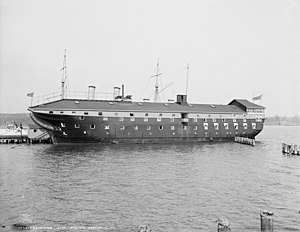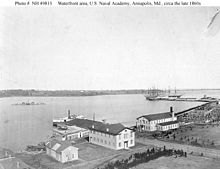
USS Santee (1855)

 The USS Santee moored at the United States Naval Academy, 1905 as a Barracks Ship.
| |
| History | |
|---|---|
| Laid down | 1820 |
| Launched | 16 February 1855 |
| Commissioned | 9 June 1861 |
| Fate |
|
| General characteristics | |
| Tonnage | 1726 |
| Length | 190 ft (58 m) (between perpendiculars) |
| Beam | 45 ft (14 m) |
| Depth of hold | 14 ft 5 in (4.39 m) |
| Propulsion | sail |
| Complement | 480 officers and enlisted |
| Armament |
|
USS Santee was a wooden-hulled, three-masted sailing frigate of the United States Navy. She was the first U.S. Navy ship to be so named and was one of its last sailing frigates in service. She was acquired by the Union Navy at the start of the American Civil War, outfitted with heavy guns and a crew of 480, and was assigned as a gunboat in the Union blockade of the Confederate States. She later became a training ship then a barracks ship for the U.S. Naval Academy.

Service history
Rated at 44 guns, she was laid down in 1820 by the Portsmouth Navy Yard, but due to a shortage of funds, she long remained uncompleted on the stocks. She was finally launched on 16 February 1855, but not commissioned until 9 June 1861, Captain Henry Eagle in command.[1] Santee departed Portsmouth, New Hampshire on 20 June 1861, stopped at Hampton Roads, Virginia to load ammunition, and resumed her voyage to the Gulf of Mexico on 10 July.[1] On 8 August, the frigate captured the schooner C. P. Knapp in the gulf some 350 miles south of Pensacola and escorted the blockade runner to that port. On 27 October, Santee took her second prize, Delta, off Galveston; the hermaphrodite brig had attempted to slip into Galveston with a cargo of salt from Liverpool.[1]

Shortly before midnight on 7 November, boats left the frigate and entered Galveston Bay hoping to capture and burn the Confederate armed steamer, General Rusk. However, in attempting to avoid detection, the boats ran aground.[1] Since he had lost the advantage of surprise, the expedition's commander, Lt. James Edward Jouett, cancelled his plans to attack General Rusk and turned his attention to the chartered Confederate lookout vessel, CS Royal Yacht. After a desperate hand-to-hand fight, he captured Royal Yacht's crew, set the armed schooner afire, and retired to Santee with about a dozen prisoners.[1] During the action, one man from the frigate was killed and two of her officers and six of her men were wounded, one mortally.[1] A young 15-year-old sailor named James Henry Carpenter was wounded in the thigh and mentioned in dispatches due to his actions. Carpenter would become Santee's acting Master's mate and would serve again on Santee when she served as a school ship for the United States Naval Academy.[2] Another of Santee's sailors, George H. Bell, was awarded the Medal of Honor for his part in the action.[3]

On 30 December, after a five or six-mile chase on boats from Santee, they captured 14-ton Confederate schooner, Garonne. Captain Eagle stripped the prize for use as a lighter.[1] In January 1862, when the Union naval force in the Gulf of Mexico was divided into two squadrons, Santee was assigned to Flag Officer David Farragut's new West Gulf Blockading Squadron. Under the new organization, Santee continued to blockade the Texas coast, primarily off Galveston, until summer. Then, because scurvy had weakened the frigate's crew and the enlistments of many of her sailors had expired, the ship sailed north. She reached Boston, Massachusetts on 22 August and was decommissioned on 4 September.[1]


Refitted at the Boston Navy Yard, the ship was recommissioned there exactly a month later and sailed for Newport, Rhode Island, to serve as a school ship at the Naval Academy, which had been moved there from Annapolis, Maryland, for security during the Civil War. At Newport, midshipmen lived, studied, and attended classes in frigates Santee and Constitution as they prepared for positions of leadership in the Union Navy.[1] After the close of the Civil War, the Naval Academy returned to Annapolis, Maryland, and Santee, carrying midshipmen, sailed for that port and moored near Fort Severn on 2 August 1865. There, she continued her duty as school ship which she had performed at Newport.[1]

Post-war career

In 1866, she became a gunnery ship and was used by midshipmen to master the art of naval gunnery. About the same time, the frigate began to be used as a barracks ship for midshipmen being punished and for new fourthclassmen receiving their first taste of Navy life.[1]

Before dawn on 2 April 1912, after a half a century of duty as an educator, Santee sank at her mooring. Efforts to refloat the frigate proved unsuccessful.[1] She was sold to Henry A. Hitner's Sons Company, of Philadelphia, Pennsylvania, on 2 August 1912, the anniversary of her arrival at Annapolis. After six months of effort, she was finally raised; and, on 8 May 1913, Santee departed the Severn River under tow and proceeded to Boston, where she was burned for the copper and brass in her hull.[1]

See also
References
- ^ a b c d e f g h i j k l m "Santee". Dictionary of American Naval Fighting Ships. Navy Department, Naval History and Heritage Command.
- ^ US Government (2013). "Widow's Pension Claims – Claim 22,296 filed on 19 March 1903, under case #16-611, 113 images". Fold3. Retrieved 21 March 2013. (Note: Much of the history of James Henry Carpenter came from his second wife's pension files)
- ^ "Medal of Honor Recipients, Civil War (A–F)". United States Army Center of Military History. 13 August 2013. Archived from the original on 3 March 2016. Retrieved 30 August 2013.
![]() This article incorporates text from the public domain Dictionary of American Naval Fighting Ships. The entry can be found here.
This article incorporates text from the public domain Dictionary of American Naval Fighting Ships. The entry can be found here.

External links
 Media related to USS Santee (ship, 1855) at Wikimedia Commons
Media related to USS Santee (ship, 1855) at Wikimedia Commons- Journal of the Officer of the Day, U.S.S. Santee, 1864, MS 123 and Journal of the Officer of the Day, U.S.S. Santee, 1865-1866, MS 124 held by Special Collections & Archives, Nimitz Library at the United States Naval Academy
- Ships of the Union Navy
- Ships built in Kittery, Maine
- Sailing frigates of the United States Navy
- Gunboats of the United States Navy
- American Civil War patrol vessels of the United States
- United States Naval Academy
- Training ships of the United States Navy
- 1855 ships
- Shipwrecks of the Maryland coast
- Ship fires
- Shipwrecks of the Massachusetts coast
- Maritime incidents in 1912
- Maritime incidents in 1913
See what we do next...
OR
By submitting your email or phone number, you're giving mschf permission to send you email and/or recurring marketing texts. Data rates may apply. Text stop to cancel, help for help.
Success: You're subscribed now !
